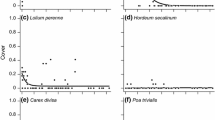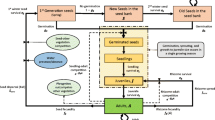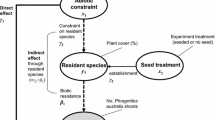Abstract
Spartina alterniflora Loisel, widely recognized as an aggressive invader of estuaries and salt marshes worldwide, was recently reported in Korean waters as rapidly invading intertidal mudflats, growing in circular patches. For more effective control management of the invasive cordgrass, we developed a modified ignition logistic model based on the satellite imageries to estimate the settlement time of the first individual stand and the doubling period of the patch spread in the early colonization state. The present model is designed for estimating the starting time and the doubling period of the patch spread at the growth stage, which is a salient feature different from other logistic models. The importance of estimating the starting time of the invasion may lie in figuring out what ecological changes occurred at that time. A Monte-Carlo simulation is combined with our model to obtain reliable predictions against the noisy data. As a result of applying the model to the Northwest Pacific invading tidal flats of Korea, China, and Japan, it turns out that the doubling periods of the patch spread are generally shorter and similar to each other, which range from 0.6 to 2.1 years. This is probably attributed to the genetically hybridized populations of Spartina alterniflora invading this region.











Similar content being viewed by others
Data Availability
All data generated or analysed during this study are included in this published article (and its supplementary information files).
Change history
19 December 2023
A Correction to this paper has been published: https://doi.org/10.1007/s10530-023-03211-3
References
An S, Gu B, Zhou C et al (2007) Spartina invasion in China: implications for invasive species management and future research. Weed Res 47(3):183–191. https://doi.org/10.1111/j.1365-3180.2007.00559.x
Anttila CK, Daehler CC, Rank NE et al (1998) Greater male fitness of a rare invader (Spartina alterniflora, Poaceae) threatens a common native (Spartina foliosa) with hybridization. Am J Bot 85(11):1597–1601. https://doi.org/10.2307/2446487
Anttila CK, King RA, Ferris C et al (2000) Reciprocal hybrid formation of Spartina in San Francisco Bay. Mol Ecol 9(6):765–770. https://doi.org/10.1046/j.1365-294x.2000.00935.x
Ayres DR, Smith DL, Zaremba K, et al (2004) Spread of Exotic Cordgrasses and Hybrids (Spartina sp.) in the Tidal Marshes of San Francisco Bay, California, USA. Biol Invasions 6(2):221–231. https://doi.org/10.1023/B:BINV.0000022140.07404.b7
Ayres DR, Zaremba K, Sloop CM et al (2008) Sexual reproduction of cordgrass hybrids (Spartina foliosa x alterniflora) invading tidal marshes in San Francisco Bay. Divers Distrib 14(2):187–195. https://doi.org/10.1111/j.1472-4642.2007.00414.x
Borges FO, Santos CP, Paula JR et al (2021) Invasion and extirpation potential of native and invasive Spartina species under climate change. Front Marine Sci. https://doi.org/10.3389/fmars.2021.696333
Bouma TJ, Vries MBD, Herman PMJ (2010) Comparing ecosystem engineering efficiency of two plant species with contrasting growth strategies. Ecol 91(9):2696–2704. https://doi.org/10.1890/09-0690.1
Buhle ER, Feist BE, Hilborn R (2012) Population dynamics and control of invasive Spartina alterniflora: inference and forecasting under uncertainty. Ecol Appl 22(3):880–893. https://doi.org/10.1890/11-0593.1
Bustamante J, Aragonés D, Afán I et al (2016) Hyperspectral sensors as a management tool to prevent the invasion of the exotic cordgrass Spartina densiflora in the Doñana wetlands. Remote Sens. https://doi.org/10.3390/rs8121001
Chung SH (2018) Features and functions of purple pigment compound in halophytic plant Suaeda japonica: Antioxidant/anticancer activities and osmolyte function in halotolerance. Korean J of Plant Resour 31(4):342–354. https://doi.org/10.7732/kjpr.2018.31.4.342
Civille JC, Sayce K, Smith SD et al (2005) Reconstructing a century of Spartina alterniflora invasion with historical records and contemporary remote sensing. Ecoscience 12(3):330–338. https://doi.org/10.2980/i1195-6860-12-3-330.1
Correll MD, Hantson W, Hodgman TP et al (2019) Fine-scale map** of coastal plant communities in the northeastern USA. Wetlands 39(1):17–28. https://doi.org/10.1007/s13157-018-1028-3
Costanza R, D’Arge R, de Groot R et al (1997) The value of the world’s ecosystem services and natural capital. Nat 387(6630):253–260. https://doi.org/10.1038/387253a0
Crooks JA (2009) The role of exotic marine ecosystem engineers. In: Rilov G, Crooks JA (eds) Biological invasions in marine ecosystems: ecological, management, and geographic perspectives. Springer, Berlin, Heidelberg
Davis MA (2003) Biotic globalization: does competition from introduced species threaten biodiversity? Biosci 53(5):481–489. https://doi.org/10.1641/0006-3568(2003)053[0481:BGDCFI]2.0.CO;2
Deegan LA, Johnson DS, Warren RS et al (2012) Coastal eutrophication as a driver of salt marsh loss. Nat 490(7420):388–392. https://doi.org/10.1038/nature11533
Gedan KB, Silliman B, Bertness M (2009) Centuries of human-driven change in salt marsh ecosystems. Ann Rev Mar Sci 1:117–141. https://doi.org/10.1146/annurev.marine.010908.163930
Granse D, Suchrow S, Jensen K (2021) Long-term invasion dynamics of Spartina increase vegetation diversity and geomorphological resistance of salt marshes against sea level rise. Biol Invasions 23(3):871–883. https://doi.org/10.1007/s10530-020-02408-0
Hayakawa K, Agarie S (2010) Physiological roles of betacyanin in a halophyte Suaeda japonica makino. Plant Product Sci 13(4):351–359. https://doi.org/10.1626/pps.13.351
Hui C, M. RD, Landi P, et al (2021) Trait positions for elevated invasiveness in adaptive ecological networks. Biol Invasions 23:1965–1985
Hwang JW, Lee KW, Park HS (2022) Growth rate and annual production of halo-phyte (Suaeda japonica) on tidal mud-flat, southern part of Ganghwa-isl, Korea. Ocean Polar Res 44(2):127–137. https://doi.org/10.4217/OPR.2022014
JMOE (2012) 2011 Survey report of the invasion of exotic species in the coastal area and tidal flat of Kyusu. Tech. rep, Japanese Ministry of Environment, Tokyo
JMOE (2013) 2012 Survey report of the invasion of exotic species in the coastal area and tidal flat of Aichi. Tech. rep, Japanese Ministry of Environment, Tokyo
JMOE (2015) Invasive Spartina Eradication Project completed in the Shiragawa River. https://www.env.go.jp/press/101410.html, accessed: 2022-04-25
Jung S, Park S, Lee K, et al (2015) A potential risk of invasive alien plants of gen. Spartina(poaceae) in South Korea. In: 46th Annual meeting Korean society of plant taxonomists, Inha Univ., p 49
KHOA (2016) 2016 Annual Report of Korea Oceanographic Observation Network. Tech. rep, Korea Hydrographic and Oceanographic Agency
Kim EK, Kil J, Joo YK et al (2015) Distribution and Botanical Characteristics of Unrecorded Alien Weed Spartina anglica in Korea. Weed & Turfgrass Sci 4(1):65–70. https://doi.org/10.5660/WTS.2015.4.1.65
Kim S, Yu C, Ruesink J et al (2023) Vertical distribution of the salt marsh invader Spartina alterniflora and native halophytes on the west coast of Korea in relation to tidal regimes. Aquat Invasions 18(3):331-349. https://doi.org/10.3391/ai.2023.18.3.104556
Kimura T, Hanai T, Kimura S et al (2016) Identification of invasive alien species Spartina alterniflora in Japan using morphological characteristics as compared with native species Phragmites Australis. Jpn J Benthol 70:91–94
Kong L (2021) The grass that took over half of China’s salt marshes. https://chinadialogueocean.net/en/conservation/18560-the-grass-that-took-over-half-of-chinas-salt-marshes/, accessed: 2022-04-25
Lee HG, Park HS, Hong JS et al (2006) Spatio-temporal variation in the benthic environmental conditions and salt marsh vegetation in Donggeomdo, Incheon, Korea. Korean J Fisher Aquat Sci 39:180–188. https://doi.org/10.5657/kfas.2006.39.spc1.180
Lee KS, Oh KC (1989) Difference of Suaeda japonica populations from two different habitats in Sorae, Incheon, Korea. Korean J Ecol 12(3):133–144
Levin LA, Neira C, Grosholz ED (2006) Invasive cordgrass modifies wetland trophic function. Ecol Soc Am 87(2):419–432. https://doi.org/10.1890/04-1752
Maebara Y, Tamaoki M, Iguchi Y, et al (2020) Genetic Diversity of Invasive Spartina alterniflora Loisel. (Poaceae) Introduced Unintentionally Into Japan and Its Invasion Pathway. Front Plant Sci https://doi.org/10.3389/fpls.2020.556039
Matsuda R, Yamada K, Oda T et al (2021) Expansion of an invasive alien species Spartina alterniflora that invaded the Ohno River in the inner part of the Yatsushiro Sea. Jpn J Benthol 76:50–58. https://doi.org/10.5179/benthos.76.50
Meng W, Feagin RA, Innocenti RA et al (2020) Invasion and ecological effects of exotic smooth cordgrass Spartina alterniflora in China. Ecol Eng 143(105):670. https://doi.org/10.1016/j.ecoleng.2019.105670
Min BM (2005) Ecological characteristics of a Suaeda japonica population and the effects of early-season air temperatures on population formation. J Plant Biol 48:411–421. https://doi.org/10.1007/BF03030583
Pennings SC, Bertness MD (2001) Salt Marsh Communities. In: Bertness MD, Gaines S, Hay M (eds) Marine community ecology, 1st edn. Sinauer, Massachusetts, chap 11, p 289–316
Sakai AK, Allendorf FW, Holt JS et al (2001) The population biology of invasive species. Annu Rev Ecol Syst 32(1):305–332. https://doi.org/10.1146/annurev.ecolsys.32.081501.114037
Silliman BR (2014) Salt marshes. Curr Biol 24(9):R348–R350. https://doi.org/10.1016/j.cub.2014.03.001
Simberloff D, Martin JL, Genovesi P et al (2013) Impacts of biological invasions: what’s what and the way forward. Trends Ecol Evolut 28(1):58–66. https://doi.org/10.1016/j.tree.2012.07.013
Strayer DL, Eviner VT, Jeschke JM et al (2006) Understanding the long-term effects of species invasions. Trends Ecol Evolut 21(11):645–651. https://doi.org/10.1016/j.tree.2006.07.007
Strong DR, Ayres DA (2009) Spartina Introductions and Consequences in Salt Marshes. In: Brian R. Silliman MDBEdwin D. Grosholz (ed) Human impacts on salt marshes: a global perspective, first edit edn. June, University of California Press, Berkeley and Los Angeles, p 3–22
Strong DR, Ayres DR (2013) Ecological and evolutionary misadventures of Spartina. Annu Rev Ecol Evol Syst 44(1):389–410. https://doi.org/10.1146/annurev-ecolsys-110512-135803
Vitousek PM, Mooney HA, Lubchenco J et al (1997) Human domination of earth’s ecosystems. Sci 277(5325):494–499. https://doi.org/10.1126/science.277.5325.494
Wan H, Wang Q, Jiang D et al (2014) Monitoring the invasion of Spartina alterniflora using very high resolution unmanned aerial vehicle imagery in Beihai, Guangxi (China). Sci World J 2014:7. https://doi.org/10.1155/2014/638296
Wang A, Chen J, **g C et al (2015) Monitoring the invasion of Spartina alterniflora from 1993 to 2014 with Landsat TM and SPOT 6 satellite data in Yueqing Bay. China. PLOS ONE 10(8):1–17. https://doi.org/10.1371/journal.pone.0135538
Zedler JB, Kercher S (2005) Wetland resources: status, trends, ecosystem services, and restorability. Annu Rev Environ Resour 30:39–74. https://doi.org/10.1146/annurev.energy.30.050504.144248
Zhang R, Shen Y, Lu L et al (2004) Formation of Spartina alterniflora salt marshes on the coast of Jiangsu Province China. Ecol Eng 23(2):95–105. https://doi.org/10.1016/j.ecoleng.2004.07.007
Zhang Y, Wang Q, Lu M et al (2008) Variation and phenotypic plasticity in life history traits of Spartina alterniflora along the east coast of China. Biodiv Sci 16(5):462. https://doi.org/10.3724/SP.J.1003.2008.08108
Zuo P, Zhao S, Liu C et al (2012) Distribution of Spartina spp. along China’s coast. Ecol Eng 40:160–166. https://doi.org/10.1016/j.ecoleng.2011.12.014
Acknowledgements
This work is supported by the National Research Foundation of Korea (NRF) grant funded by the Korean government (MSIT) (No. 2020R1F1A1A01049994). A part of the work was supported under the project title of “Spartina: Status and Distribution in Korean Waters” by the Korea Marine Environment Corporation through Grant No. 2015 from the Korea Institute of Coastal Ecology Inc. in 2015.
Funding
This work is supported by the National Research Foundation of Korea (NRF) grant funded by the Korean government (MSIT) (No. 2020R1F1A1A01049994). A part of the work was supported under the project title of “Spartina: Status and Distribution in Korean Waters” by the Korea Marine Environment Corporation through Grant No. 2015 from the Korea Institute of Coastal Ecology Inc. in 2015.
Author information
Authors and Affiliations
Contributions
All authors contributed to the study conception and design. Do Wan Kim and Jae-Sang Hong obtained the research funding. Data collection and analysis were performed by Sungtae Kim and the mathematical model was designed by Do Wan Kim. The first draft of the manuscript was written by Jae-Sang Hong and all authors commented on subsequent versions of the manuscript. All authors read and approved the final manuscript.
Corresponding author
Ethics declarations
Conflict of interest
The authors have no conflicts of interest to declare that are relevant to the content of this article.
Additional information
Publisher's Note
Springer Nature remains neutral with regard to jurisdictional claims in published maps and institutional affiliations.
The original online version of this article was revised: In Table 7 of this article, the country name ‘China’ under the column heading ‘Region’ is mistakenly listed in ‘Row 2’. It should be listed in ‘Row 3’.
Appendices
Appendix A: Derivation of the ignition logistic function
For the solution of the ignition logistic model defined in (7) with initial condition (8), we start from the separation of variables of the differential equation,
because of the initial condition that \(A = 0\) when \(t = t_0\). Using the definition of \(A^\pm\) in (11), the left hand side of (A1) can be calculated to reach
Considering the left hand side of (A1), we reach the following identity,
Solve this equation for the variable A and we finally obtain the ignition logistic function written in (9).
Appendix B: The correspondence in Table 1
Comparing (9) and (10) with (12) and (13), respectively, we find the following four relationships, where \(\delta _0\), \(\delta _1\), \(\delta _2\), and \(\delta _3\) are parameters determined from the fitting model:
where the values, \(t_c\) and \(t_R\), are determined from the data in terms of (15). From equations (B4) and (B5), we infer that \(A^- = \delta _2\,\delta _3/(1-\delta _2)\) and \(A^- + A^+ = \delta _3/(1-\delta _2)\). Therefore, substituting these values into equation (B6), we obtain
Eliminating the quantity \(\alpha (A^- + A^+)\) from equations (B6) and (B7), we find
Given the identity \(\Delta = (A^*)^2 + 4 \beta /\alpha\), and knowing that \(A^- + A^+ = \sqrt{\Delta }\) and \(A^+ - A^- = A^*\) from (11), we deduce that \(\beta = \alpha \,A^- A^+\). As a result, we have
Meanwhile, let us estimate the initial doubling period \(T > 0\). For a sufficiently small time just after \(t_0\), E(t) in (10) is small enough to have the following asymptotic behavior of the ignition logistic function \(A^{ILM}(t)\) in (9):
as E(t) goes to zero. Comparing the leading term of (B8) with that of (4), the following relationship should be satisfied:
Based on the identity that \(\alpha \,(A^-+A^+) = {\delta _0}/{t_R}\), it is reasonable to define the initial doubling period T in the ILM as follows:
Appendix C: Error bound in (21)
Using \(\vert \partial D_i \vert = 2 \sqrt{\pi } \sqrt{\vert D_i \vert }\), the summation on the right-hand side of (20) is addressed as
Indeed, based on the inequality \(\sqrt{\vert D_i \vert }\, \sqrt{\vert D_j \vert } \le \frac{1}{2} \left( \vert D_i \vert + \vert D_j \vert \right)\), the direct calculation yields
Here, the last equality comes from the fact that \(\sum _{i=1}^{N^p} \vert D_i \vert = \sum _{j=1}^{N^p} \vert D_j \vert = \vert D \vert\), which is based on the property of disjoint union. It is worth noting that the inequality in (21) holds even if \(D = \bigcup _{i=1}^{N^p}\) is not a disjoint union.
Rights and permissions
Springer Nature or its licensor (e.g. a society or other partner) holds exclusive rights to this article under a publishing agreement with the author(s) or other rightsholder(s); author self-archiving of the accepted manuscript version of this article is solely governed by the terms of such publishing agreement and applicable law.
About this article
Cite this article
Kim, S., Hong, JS. & Kim, D.W. Diffusion model for initial colonization of Spartina patches on Korean tidal flats. Biol Invasions 26, 403–421 (2024). https://doi.org/10.1007/s10530-023-03179-0
Received:
Accepted:
Published:
Issue Date:
DOI: https://doi.org/10.1007/s10530-023-03179-0




